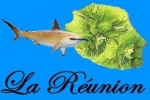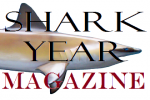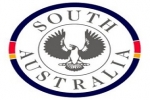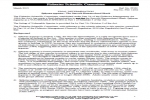Assessing the viability of releasing captive-bred wobbegongs to restock depleted populations
Published on 09. April 2015 Born to be free? Assessing the viability of releasing captive-bred wobbegongs to restock depleted populations Kathryn A. Lee, Charlie Huveneers, Victor Peddemors, Andrew Boomer, Robert G. Harcourt ABSTRACT: Large predatory fishes, such as sharks, play an important functional role within marine ecosystems. Restocking of depleted populations has been extensively studied
Reconstructing habitat use by juvenile salmon sharks links upwelling to strandings in the California Current
Published on 09. April 2015 Reconstructing habitat use by juvenile salmon sharks links upwelling to strandings in the California Current Aaron B. Carlisle, Steven Y. Litvin, Elliott L. Hazen, Daniel J. Madigan, Kenneth J. Goldman, Robert N. Lea, Barbara A. Block ABSTRACT: The use of nursery areas by elasmobranchs is an important life history strategy
Ecological Drivers of Shark Distributions along a Tropical Coastline
Published on 08. April 2015 Ecological Drivers of Shark Distributions along a Tropical Coastline Peter M. Yates, Michelle R. Heupel, Andrew J. Tobin, Colin A. Simpfendorfer ABSTRACT: As coastal species experience increasing anthropogenic pressures there is a growing need to characterise the ecological drivers of their abundance and habitat use, and understand how they may
Development and microstructure of tooth histotypes in the blue shark and the great white shark
Published on 03. April 2015 Development and microstructure of tooth histotypes in the blue shark, Prionace glauca (Carcharhiniformes: Carcharhinidae) and the great white shark, Carcharodon carcharias (Lamniformes: Lamnidae) Joshua K. Moyer, Mark L. Riccio, William E. Bemis ABSTRACT: Elasmobranchs exhibit two distinct arrangements of mineralized tissues in the teeth that are known as orthodont and
Effect of the Deep Sea Shark-liver Oil Component Food on Secretion Type Immunoglobulin A Density of Saliva in the Normal Man and Woman Adult
Published on 10. April 2015 Effect of the Deep Sea Shark-liver Oil Component Food on Secretion Type Immunoglobulin A Density of Saliva in the Normal Man and Woman Adult Naobumi Hamadate, Yoshiyuki Matsumoto, Mami Shikura, Chiemi Mizukami, Kayoko Seto, Tetsuro Yamamoto, Hideyo Yamaguchi, Muneaki Iizuka, Etsushi Yamamoto, Sumio Kondo, Kazunaga Yazawa ABSTRACT: Secretory immunoglobulin A
Réunion Island: Teenage Boy Killed in Shark Attack off Cap Homard
Helmut Nickel (mail), Shark Year Magazine, 12. April 2015 A 13-year-old surfer (other source: bodyboarder) was killed by a shark this morning on the French island of Réunion in the Indian Ocean. The incident occurred shortly after 9 a.m. in the waters near Cap Homard which is located in the commune of Saint-Paul on the
Man suffered suspected shark bite at McKenzies Beach, NSW
News Release Surf Life Saving, New South Wales 11. April 2015 —————- Statement Regarding Reported Shark Encounter at McKenzies Beach A number of beaches along the State’s Far South Coast will remain closed on Saturday afternoon following reports that a man suffered a suspected shark bite while paddleboarding at McKenzies Beach. The incident at the
Laser photogrammetry improves size and demographic estimates for whale sharks
Published on 07. April 2015 Laser photogrammetry improves size and demographic estimates for whale sharks Christoph A. Rohner, Anthony J. Richardson, Clare E.M. Prebble, Andrea D. Marshall, Michael B. Bennett, Scarla J.Weeks, Geremy Cliff, Sabine P.Wintner, Simon J. Pierce ABSTRACT: Whale sharks Rhincodon typus are globally threatened, but a lack of biological and demographic information
Industry Request for Alternative Shark Cage Diving Sites in South Australia
Media Release Government of South Australia Department of Environment, Water and Natural Resources 02. April 2015 ——————- State Government to consider alternatives sites for shark cage diving The State Government is continuing to work with the shark cage diving industry following an industry request to operate at sites other than the Neptune Islands Conservation Park.
AU: Smooth hammerhead shark not eligible for listing as vulnerable species in New South Wales
Fisheries Scientific Committee March 2015 Ref. No. FD52 File No. FSC 12/02 FINAL DETERMINATION Sphyrna zygaena – The Smooth Hammerhead Shark The Fisheries Scientific Committee, established under Part 7A of the Fisheries Management Act 1994 (the Act), has made a final determination to not list the Smooth Hammerhead Shark, Sphyrna zygaena as a VULNERABLE SPECIES
Acoustic telemetry reveals cryptic residency of whale sharks
Published on 01. April 2015 Acoustic telemetry reveals cryptic residency of whale sharks E. Fernando Cagua, Jesse E. M. Cochran, Christoph A. Rohner, Clare E. M. Prebble, Tane H. Sinclair-Taylor, Simon J. Pierce, Michael L. Berumen ABSTRACT: Although whale sharks (Rhincodon typus) have been documented to move thousands of kilometres, they are most frequently observed
Levels of arsenic, cadmium, lead and mercury in mobulid rays
Published online on 16. March 2015 Levels of arsenic, cadmium, lead and mercury in the branchial plate and muscle tissue of mobulid rays Michelle S.M. Ooi, Kathy A. Townsend, Michael B. Bennett, Anthony J. Richardson, Daniel Fernando, Cesar A. Villa, Caroline Gaus ABSTRACT: Mobulid rays are targeted in fisheries for their branchial plates, for use







